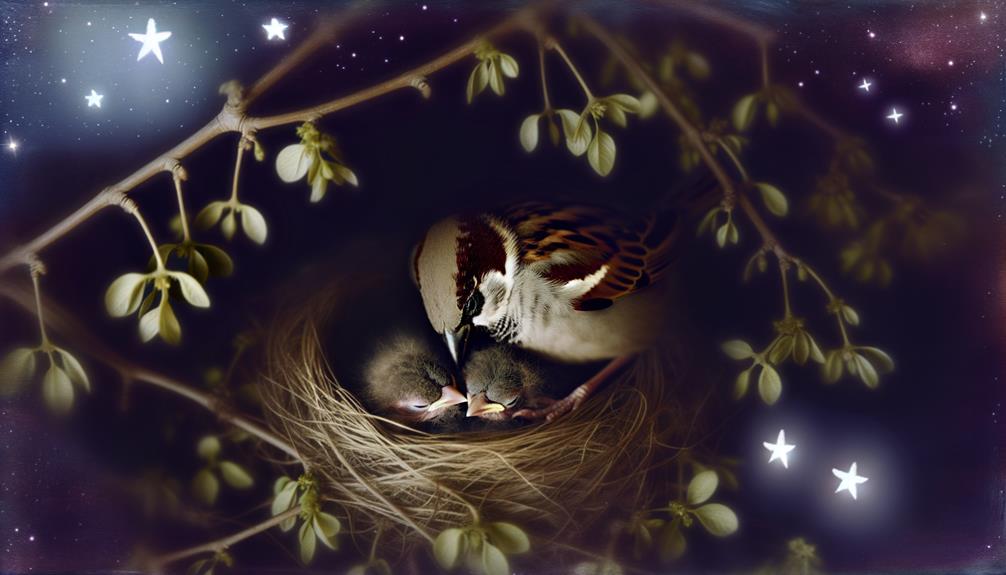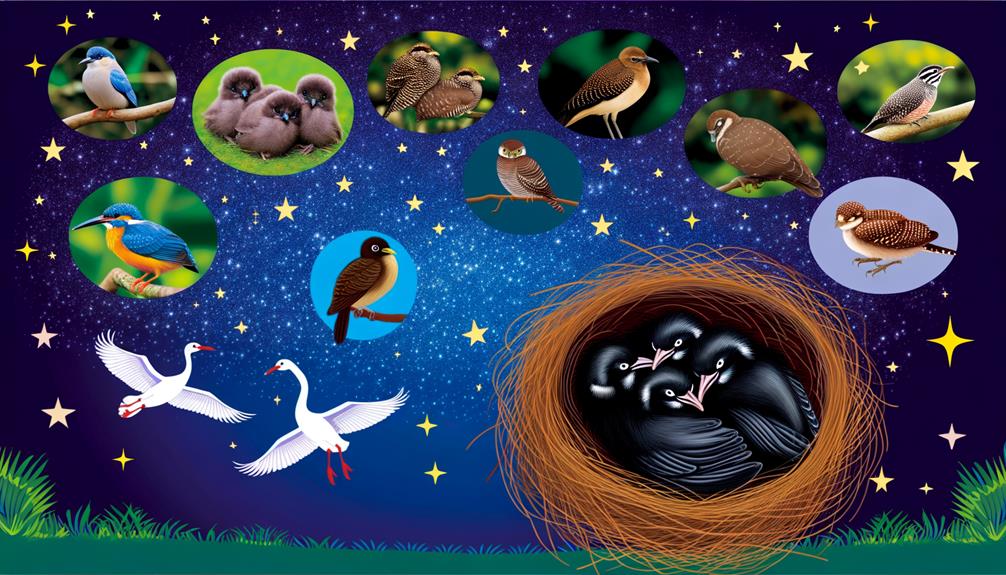Understanding Sparrow Nesting – Do Sparrows Sleep With Their Babies?
Sparrows don't sleep with their babies; instead, they roost nearby to guarantee the chicks' safety. They carefully select nesting sites and construct insulated nests with feathers to uphold warmth.
At night, adult sparrows position themselves close to the nest to guard and shield their young from predators and environmental hazards. They continue to provide parental care by keeping a vigilant watch and using vocalizations to communicate.
This behavior maximizes offspring survival, offering protection even during nocturnal hours. Interested in how sparrow behaviors compare with other birds? There's plenty more fascinating detail to uncover.

Key Takeaways
- Adult sparrows do not sleep with their babies but stay nearby for protection.
- Sparrows seek sheltered locations for roosting, often close to their nest.
- Parental care continues at night with adults maintaining proximity to provide warmth.
- Adult sparrows act as barriers against environmental hazards for their chicks.
- Observational studies confirm that adults guard the nest from nearby perches rather than inside it.
Sparrow Nesting Habits

A sparrow's nesting habits are characterized by meticulous construction using grass, twigs, and feathers to create a secure environment for their eggs. You'll observe that sparrows select nesting sites with great care, often opting for locations that provide protection from predators and harsh weather.
By using materials like soft feathers, they guarantee thermal insulation, crucial for egg incubation. Research indicates that these nests, typically built in dense foliage or hidden crevices, enhance the survival rate of the offspring.
Sparrows also demonstrate remarkable adaptability; they can repurpose human-made structures. This behavior ensures that their nests are both resilient and strategically placed. By understanding these nesting habits, you can better support conservation efforts, guaranteeing these resilient birds continue to thrive.
Nighttime Behavior
You'll observe that sparrows exhibit specific roosting habits, often seeking sheltered spots during nighttime.
Their nesting patterns reveal a tendency to maintain close proximity to their young, ensuring warmth and protection.
Evidence indicates that parental care doesn't cease at night, as adult sparrows frequently return to the nest to check on their offspring.
Roosting Habits
Sparrows exhibit specific roosting habits at night, often seeking sheltered locations to protect themselves and their young from predators and harsh weather conditions. You'll find sparrows using dense foliage, crevices, or even human-made structures for roosting. These choices are strategic, ensuring they remain hidden and safe.
| Roosting Location | Benefits | Examples |
|---|---|---|
| Dense Foliage | Concealment from predators | Bushes, hedges |
| Crevices | Protection from elements | Tree holes, rock gaps |
| Human-made Structures | Accessibility and safety | Barns, eaves of houses |
Observations reveal that sparrows prefer locations that offer maximum concealment and safety, significantly reducing their vulnerability during nighttime. This behavior underscores their adaptive strategies for survival, ensuring both adults and fledglings remain unharmed.
Nesting Patterns
When night falls, observe how these small birds exhibit intricate nesting patterns, often characterized by their meticulous arrangement of nesting materials to secure warmth and protection for their young.
You'll notice sparrows select diverse materials such as grass, feathers, and twigs, weaving them into a compact structure. This nest design secures thermal insulation, crucial for the chicks' survival during colder nights.
Additionally, sparrows strategically position their nests in concealed locations, such as dense foliage or crevices, to deter predators. These behaviors aren't random; they're evidence-based adaptations enhancing offspring survival rates.
Parental Care
Observing their nighttime behavior, it's evident that sparrows exhibit a high level of parental care by staying close to their chicks, ensuring they remain warm and protected throughout the night.
You'll notice that adult sparrows often roost within the nest or in its immediate vicinity. This behavior minimizes the risk of predation and exposure to cold temperatures. Studies indicate that such proximity facilitates thermoregulation and reduces chick mortality rates.
Additionally, parental vigilance during nocturnal hours deters potential predators. By maintaining this constant presence, sparrows enhance their offspring's chances of survival.
If you're committed to fostering a nurturing environment, understanding and emulating the sparrow's dedication can inspire you to provide unwavering support and protection to those in your care.
Parent-Child Interaction

In the world of avian behavior, you'll find that parent-child interaction among sparrows is both intricate and meticulously timed, ensuring best care and protection for the young. Parents exhibit pronounced biparental care, each adult taking turns to feed the nestlings with high-frequency visits.
Observations reveal that parents employ specific vocalizations to communicate with their chicks, fostering a responsive feeding process. The feeding intervals are carefully regulated, optimizing nutrient intake and growth. Parents also engage in preening behaviors, removing parasites from the chicks' feathers.
Scientific studies indicate that such active engagement enhances the survival rate of the offspring. By closely monitoring and interacting with their young, sparrow parents maximize the developmental success of the next generation, exemplifying dedicated parental investment.
Warmth and Protection
Sparrow parents secure their chicks' warmth and protection by meticulously constructing well-insulated nests and using their own bodies to shield the young from environmental hazards. The nests are carefully lined with soft materials like feathers and grass, creating a microenvironment that conserves heat.
You'll notice sparrow parents often huddling over their chicks, using their plumage to provide an additional layer of thermal insulation.
- Thermal Regulation: Chicks' body temperature is maintained through direct contact with parents.
- Predator Deterrence: Parental presence discourages predators from approaching the nest.
- Weather Shielding: Parents act as barriers against rain and wind, ensuring chicks remain dry and warm.
These behaviors highlight the sparrows' commitment to ensuring their offspring's survival and well-being through warmth and protection.
Nest Safety Measures
You'll find that sparrows utilize specific predator deterrence techniques to guarantee the safety of their nests. They also adopt weather protection strategies, such as choosing sheltered locations and incorporating water-resistant materials.
Detailed observations show that sparrows select nest construction materials like twigs, grasses, and feathers to create a secure environment.
Predator Deterrence Techniques
To protect their nests from predators, sparrows employ various deterrence techniques. These smart choices lessen the risk of predation.
- Hidden Nesting Sites: Sparrows often choose dense foliage or cavities to conceal their nests from predators' view.
- Intricate Nest Architecture: They build nests with multiple layers and elaborate structures, making it challenging for predators to access the eggs or chicks.
- Decoy Nests: Some sparrow species construct additional empty nests nearby to confuse and mislead predators.
Weather Protection Strategies
In anticipation of harsh weather conditions, sparrows carefully construct their nests to provide excellent insulation and protection for their young.
You'll observe that sparrows choose nesting sites with natural windbreaks, such as dense foliage or tree cavities.
They line their nests with soft materials, ensuring a snug microclimate. This strategic layering reduces heat loss and shields from rain.
The nest's architecture often includes a dome-like structure, effectively deflecting wind and precipitation. Evidence shows nests with tighter weaves are more resilient against weather extremes.
Additionally, sparrows exhibit nest maintenance behaviors, continually reinforcing their structures.
Nest Construction Materials
Sparrows meticulously select and gather a variety of materials, such as grasses, feathers, and twigs, to construct their nests, ensuring both structural integrity and safety for their young. By choosing specific materials, they achieve ideal insulation, cushioning, and camouflage, which are crucial for the nest's functionality.
Grasses provide flexibility and a sturdy foundation, essential for maintaining the nest's shape.
Feathers offer excellent insulation, keeping the nest warm and cozy.
Twigs add structural support, making the nest resilient against physical disturbances.
You can observe that sparrows prioritize safety measures, such as selecting thorny twigs to deter predators. By understanding these behaviors, you can better appreciate the sparrow's innate drive to protect and nurture their offspring.
Developmental Stages
Ever wondered how sparrow nestlings progress through their early developmental stages, from hatching to fledging?
When they hatch, sparrow chicks are altricial, meaning they're born blind, naked, and entirely dependent on parental care. You'll notice rapid growth within the first week; their eyes open around day five, and feathers start emerging. By day ten, they exhibit significant feather development, enhancing their thermal regulation.
Parents diligently feed and protect them, ensuring best growth. Around two weeks post-hatching, nestlings begin wing-flapping exercises, preparing for fledging. Typically, by day 14 to 17, they're ready to leave the nest, exploring their environment while still receiving parental support.
This progression underscores the optimal role of parental investment in sparrow chick survival and independence.
Comparison With Other Birds

When comparing sparrow nesting habits to those of other bird species, you'll find significant variations in parental care, developmental timelines, and fledgling independence.
Sparrows generally exhibit intensive care during the early stages, but other birds may differ considerably in their approaches.
- Parental Care: Unlike sparrows, altricial birds like robins may leave their young unattended for longer periods, relying on concealment.
- Developmental Timelines: Precocial species, such as ducks, have chicks that are more developed at hatching, requiring minimal parental assistance.
- Fledgling Independence: Raptors, like eagles, have a prolonged fledgling period, with young staying in nests for months, compared to sparrows' rapid weaning process.
These variations highlight the diverse evolutionary strategies birds employ to secure the survival of their offspring.
Observational Studies
To understand these diverse nesting behaviors in a more profound manner, observational studies offer invaluable insights into the specific practices and routines of sparrow parental care. By closely monitoring sparrow nests, researchers can identify patterns in sleep behaviors, feeding schedules, and protection strategies.
You'll find that adult sparrows often remain near the nest, but they don't typically sleep with their babies. Instead, they guard from nearby perches, ensuring safety while minimizing disturbance.
Data collected from these studies show that the presence of adult sparrows near the nest notably reduces predation risks. This evidence-based approach highlights the importance of continuous observation and data collection to fully comprehend the nuanced behaviors of sparrow families, ultimately aiding in their conservation and welfare.
Conclusion
You've observed that sparrows, while not sleeping directly with their babies, do guarantee their nestlings remain safe and warm. Through vigilant nighttime behavior and nest safety measures, parent sparrows create a secure environment.
Evidence from observational studies shows that this separation fosters independence during developmental stages. Unlike some bird species, sparrows prioritize nest integrity over constant physical closeness.
So, while they're nearby, they're not cuddled up, ensuring both protection and growth for their young.






